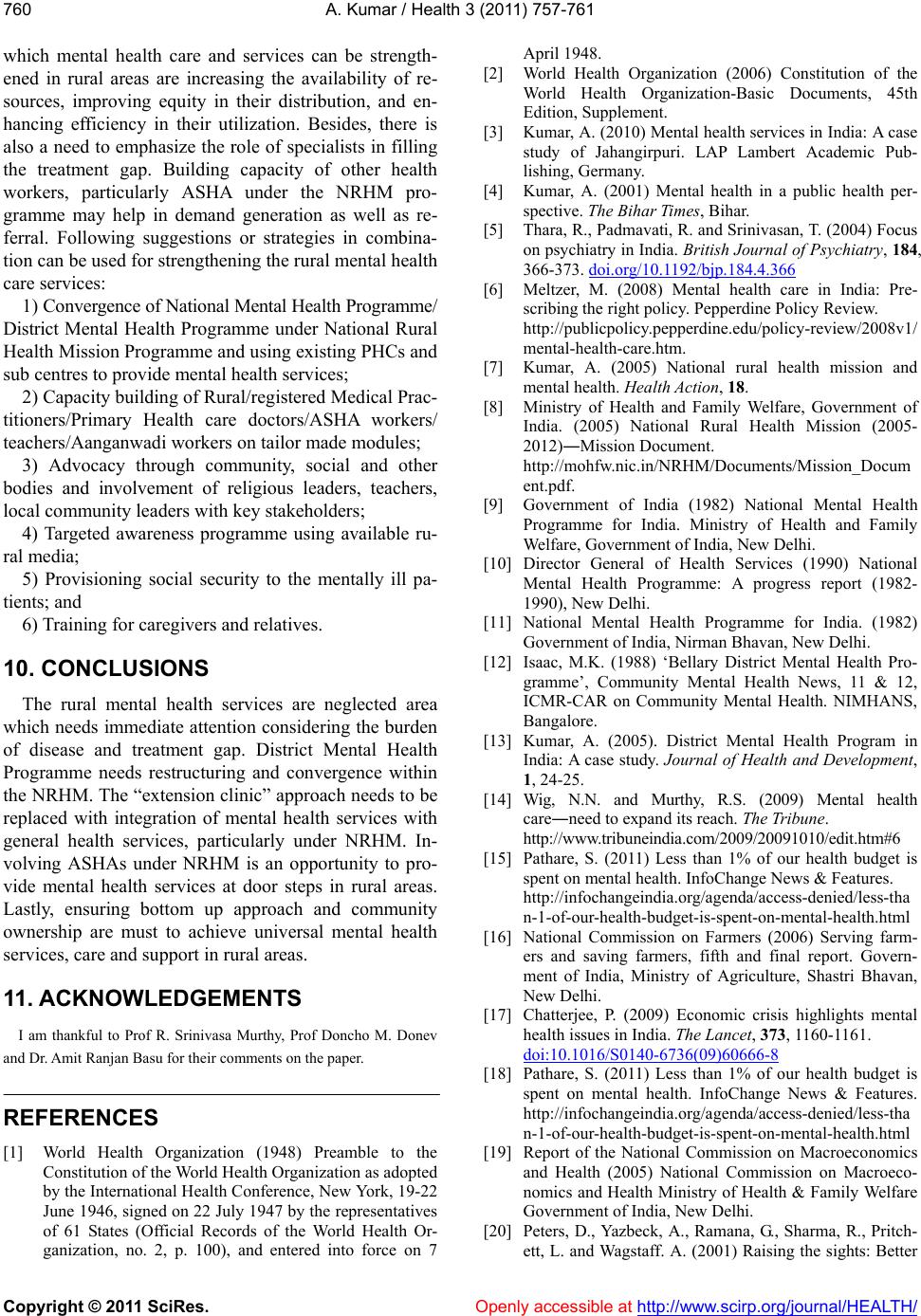
A. Kumar / Health 3 (2011) 757-761
Copyright © 2011 SciRes. Openly accessible at http:// www.scirp.org/journal/HEALTH/
760
which mental health care and services can be strength-
ened in rural areas are increasing the availability of re-
sources, improving equity in their distribution, and en-
hancing efficiency in their utilization. Besides, there is
also a need to emphasize the role of specialists in filling
the treatment gap. Building capacity of other health
workers, particularly ASHA under the NRHM pro-
gramme may help in demand generation as well as re-
ferral. Following suggestions or strategies in combina-
tion can be used for strengthening the rural mental health
care services:
1) Convergence of National Mental Health Programme/
District Mental Health Programme under National Rural
Health Mission Programme and using existing PHCs and
sub centres to provide mental health services;
2) Capacity building of Rural/registered Medical Prac-
titioners/Primary Health care doctors/ASHA workers/
teachers/Aanganwadi workers on tailor made modules;
3) Advocacy through community, social and other
bodies and involvement of religious leaders, teachers,
local community leaders with key stakeholders;
4) Targeted awareness programme using available ru-
ral media;
5) Provisioning social security to the mentally ill pa-
tients; and
6) Training for caregivers and relatives.
10. CONCLUSIONS
The rural mental health services are neglected area
which needs immediate attention considering the burden
of disease and treatment gap. District Mental Health
Programme needs restructuring and convergence within
the NRHM. The “extension clinic” approach needs to be
replaced with integration of mental health services with
general health services, particularly under NRHM. In-
volving ASHAs under NRHM is an opportunity to pro-
vide mental health services at door steps in rural areas.
Lastly, ensuring bottom up approach and community
ownership are must to achieve universal mental health
services, care and support in rural areas.
11. ACKNOWLEDGEMENTS
I am thankful to Prof R. Srinivasa Murthy, Prof Doncho M. Donev
and Dr. Amit Ranjan Basu for their comments on the paper.
REFERENCES
[1] World Health Organization (1948) Preamble to the
Constitution of the World Health Organization as adopted
by the International Health Conference, New York, 19-22
June 1946, signed on 22 July 1947 by the representatives
of 61 States (Official Records of the World Health Or-
ganization, no. 2, p. 100), and entered into force on 7
April 1948.
[2] World Health Organization (2006) Constitution of the
World Health Organization-Basic Documents, 45th
Edition, Supplement.
[3] Kumar, A. (2010) Mental health services in India: A case
study of Jahangirpuri. LAP Lambert Academic Pub-
lishing, Germany.
[4] Kumar, A. (2001) Mental health in a public health per-
spective. The Bihar Times, Bihar.
[5] Thara, R., Padmavati, R. and Srinivasan, T. (2004) Focus
on psychiatry in India. British Journal of Psychiatry, 184,
366-373. doi.org/10.1192/bjp.184.4.366
[6] Meltzer, M. (2008) Mental health care in India: Pre-
scribing the right policy. Pepperdine Policy Review.
http://publicpolicy.pepperdine.edu/policy-review/2008v1/
mental-health-care.htm.
[7] Kumar, A. (2005) National rural health mission and
mental health. Health Action, 18.
[8] Ministry of Health and Family Welfare, Government of
India. (2005) National Rural Health Mission (2005-
2012)―Mission Document.
http://mohfw.nic.in/NRHM/Documents/Mission_Docum
ent.pdf.
[9] Government of India (1982) National Mental Health
Programme for India. Ministry of Health and Family
Welfare, Government of India, New Delhi.
[10] Director General of Health Services (1990) National
Mental Health Programme: A progress report (1982-
1990), New Delhi.
[11] National Mental Health Programme for India. (1982)
Government of India, Nirman Bhavan, New Delhi.
[12] Isaac, M.K. (1988) ‘Bellary District Mental Health Pro-
gramme’, Community Mental Health News, 11 & 12,
ICMR-CAR on Community Mental Health. NIMHANS,
Bangalore.
[13] Kumar, A. (2005). District Mental Health Program in
India: A case study. Journal of Health and Development,
1, 24-25.
[14] Wig, N.N. and Murthy, R.S. (2009) Mental health
care―need to expand its reach. T he Tribune.
http://www.tribuneindia.com/2009/20091010/edit.htm#6
[15] Pathare, S. (2011) Less than 1% of our health budget is
spent on mental health. InfoChange News & Features.
http://infochangeindia.org/agenda/access-denied/less-tha
n-1-of-our-health-budget-is-spent-on-mental-health.html
[16] National Commission on Farmers (2006) Serving farm-
ers and saving farmers, fifth and final report. Govern-
ment of India, Ministry of Agriculture, Shastri Bhavan,
New Delhi.
[17] Chatterjee, P. (2009) Economic crisis highlights mental
health issues in India. The Lancet, 373, 1160-1161.
doi:10.1016/S0140-6736(09)60666-8
[18] Pathare, S. (2011) Less than 1% of our health budget is
spent on mental health. InfoChange News & Features.
http://infochangeindia.org/agenda/access-denied/less-tha
n-1-of-our-health-budget-is-spent-on-mental-health.html
[19] Report of the National Commission on Macroeconomics
and Health (2005) National Commission on Macroeco-
nomics and Health Ministry of Health & Family Welfare
Government of India, New Delhi.
[20] Peters, D., Yazbeck, A., Ramana, G., Sharma, R., Pritch-
ett, L. and Wagstaff. A. (2001) Raising the sights: Better